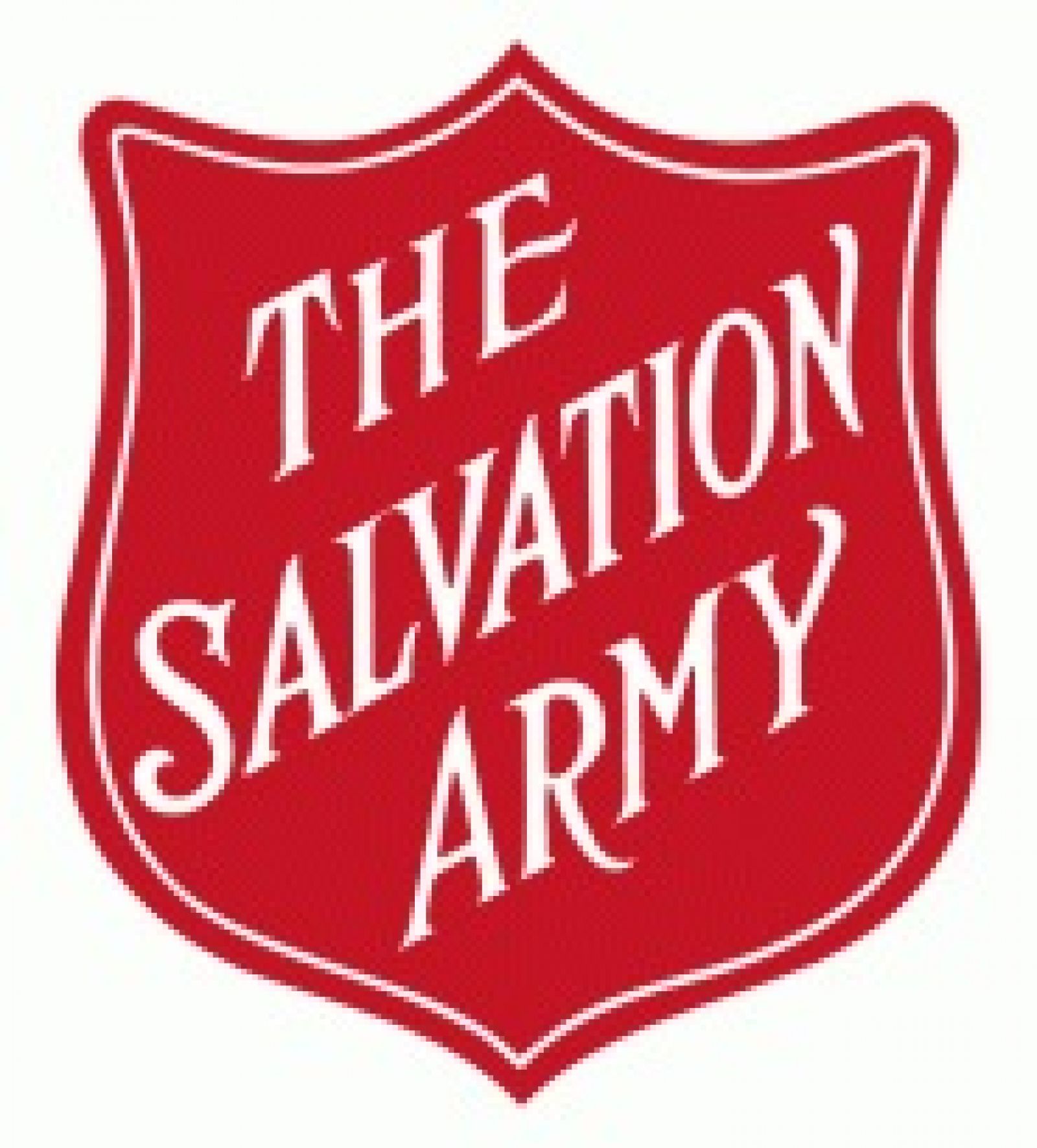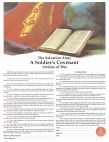
Our Symbols
The Salvation Army has many items we use in symbolic ways to reflect our faith and service. Here are but a few...
 Red Shield:
Red Shield:
The Red Shield has its origins in Salvation Army work during wartimes. At the end of the 19th Century, Staff-Captain Mary Murray was sent by William Booth to support British troops serving in the Boer War in South Africa. Then, in 1901, this same officer was given the task of establishing the Naval and Military League, the forerunner of the Red Shield Services.
Salvation Army officers serving in the Red Shield Services in wartime performed many functions. The Doughnut Girls of World War I are an early example, serving refreshments to troops in the trenches. They also provided first aid stations, ambulances, chaplaincy, social clubs, Christian worship and other frontline services.
This symbol is still used in Blue Shield Services that serve the British Armed Forces but it is widely used as a simple, more readily identifiable symbol in many Salvation Army settings. It is common to see the Red Shield used on casual Salvation Army uniform.
In Australia, the Red Shield has become one of the country's most identified and trusted brands, leading the Australian Salvation Army to prefer to use this symbol over the crest on its uniform, corps buildings and advertising materials. In the 5th Volume of Australian Superbrands it was recorded that "Research reveals that the popular Salvation Army slogan ‘Thank God for the Salvos’ has almost total recognition amongst the Australian public, achieving 93 per cent aided awareness".
The Salvation Army consistently comes out in research as the charity people would most like to donate to (named spontaneously).
Similarly the Red Shield logo is highly desired by companies wishing to link their brand with a solid emblem of care and compassion.
The uniform also gives the Salvos a very visible presence, often creating a sense that they are ‘everywhere’, although uniformed Salvationists are actually a very small percentage of the Australian population.
The Articles of War:
The Articles of War or A Soldiers Covenant is a document consisting of a series of promises and statements of belief in relation to the doctrines of The Salvation Army. All persons wanting to be enrolled as Salvation Army Soldiers must sign and promise to keep to that which is stated in the document.
The Articles of War first state that the signee has "accepted Jesus Christ as [their] Saviour and Lord", and that they "now by God's grace enter into a sacred covenant". It then states that the signee believes the eleven Salvation Army Doctrines. It follows this with a list of promises that the Soldier is to adhere to, including the promises that they will:
- "be responsive to the Holy Spirit’s work and obedient to His leading in [their] life, growing in grace through worship, prayer, service and the reading of the Bible."
- "make the values of the Kingdom of God and not the values of the world the standard for my life."
- "uphold Christian integrity in every area of my life, allowing nothing in thought. word or deed that is unworthy, unclean, untrue, profane, dishonest or immoral."
- "maintain Christian ideals in all my relationships with others: my family and neighbours, my colleagues and fellow salvationists, those to whom and for whom I am responsible, and the wider community."
- "uphold the sanctity of marriage and of family life."
- "be a faithful steward of my time and gifts, my money and possessions, my body, my mind and my spirit, knowing that I am accountable to God."
- "abstain from alcoholic drink. tobacco, the non-medical use of addictive drugs. gambling, pornography, the occult, and all else that could enslave the body or spirit."
- "be faithful to the purposes for which God raised up The Salvation Army, sharing the good news of Jesus Christ, endeavouring to win others to Him, and in His name caring for the needy and the disadvantaged."
- "be actively involved, as I am able, in the life, work, worship and witness of the corps, giving as large a proportion of my income as possible to support its ministries and the worldwide work of the Army."
- "be true to the principles and practices of The Salvation Army, loyal to its leaders, and I will show the spirit of salvationism whether in times of popularity or persecution."
The Articles conclude with a call for the Soldier to sign the document with a declaration that they "do here declare my full determination, by God’s help, to be a true soldier of The Salvation Army."
 The Uniform:
The Uniform:
Soldiers are encouraged to wear the uniform as a sign of covenant community. The uniform is a visible profession of faith in Jesus Christ and identifies the wearer with the Christian faith. The uniform also identifies the wearer as being a person who can be called upon to discover more about the Christian faith. It is seen upon like a sacrament to the Salvationist - it is an outward sign of our inward faith.
The uniform differs according to rank, nationality, and activity engaged in. Soldiers wear a blue epualette with their corps (church) name on it. Officers wear red epualettes and amrkings dependant on rank/years of service.
The uniform is not intended to identify Salvationists as in any way better than other people.
The Army believes that wearing the uniform brings many benefits:
- It identifies its wearer as a professing Christian
- It identifies its wearer as a 'servant of all'
- It is a visible invitation to others to seek the help in spiritual and social matters which a Salvationist can give
- It reminds its wearer to act in a way worthy of their calling
- It creates a feeling of comradeship with other wearers of the uniform
- It allows a soldier to represent the Army whatever his or her errand may be
 The Flag:
The Flag:
The Salvation Army flag is a symbol of the Army's war against sin and social evils. The red on the flag symbolizes the blood shed by Jesus Christ, the yellow for the fire of the Holy Spirit and the blue for the purity and holiness of God the Father.
The star contains the Salvation Army's war cry, 'Blood and Fire'. This describes the blood of Jesus shed on the cross to save all people and the fire of the Holy Spirit which purifies believers.
The flag precedes outdoor activities such as a march of witness. It is used in ceremonies such as the dedication of children and the swearing-in of soldiers. It is sometimes placed on the coffin at the funeral of a Salvationist. The Salvation Army term used to describe the death of a Salvationist is that of the deceased being "promoted to glory".
 The Mercy Seat:
The Mercy Seat:
The mercy seat is found in every Salvation Army meeting hall. It's a bench at the front where people can kneel.
The mercy seat has two main uses.
When a person decides to become a Christian they often make a public commitment by kneeling at the mercy seat during worship. However it is important to realise that the act at the mercy seat is a public statement that God has changed something in the believer's soul; it does not itself make any change in the believer.
People who are already Christians also kneel at the mercy seat, either as a public demonstration that they are re-dedicating themselves to God, or in order to pray in a special way about a particular decision or problem affecting their lives.
People can also kneel at the mercy seat as a simple act of worship.
The mercy seat is a very old idea, found first in the Old Testament, where it was the holy place where God's presence was believed to be and where he communicated with his people.
Salvationists do not believe that the mercy seat is a piece of furniture with special spiritual properties; whenever and wherever a person meets in spirit with God, that is a 'mercy seat'.
Promoted to Glory:
Promoted to Glory is a term used by The Salvation Army to describe the death of a Salvationist.
Earliest printed usage of the term seems to be in late 1882 in The War Cry, which included death announcements in the December 14 issue, with headlines such as 'Promotion of Sister Muxlow from Earth to Heaven' and 'Private Rudd goes to Glory from the Open-air.' Another report, headed 'Promotion from Cheltenham to Glory,' appeared in The War Cry of December 16, 1882.
Some Salvation Army corps have a Promoted to Glory Board or ledger on which all members (Soldiers or Adherents) of that corps, who have died, are listed along with the year of their death. It is also common for Salvationists to talk about deceased Salvationists as being "P to G'd".
The term Promoted to Glory was actually coined by Herbert Booth, son of the Founder William Booth, following the death of Catherine Booth, the Mother of the Salvation Army. He wrote the song "Promoted to Glory" which is still used at funerals today. Salvation Army funerals are typically more upbeat and are a celebration of the words "Servant of Christ, well done!"
 Salute:
Salute:
The Salvation Army has a unique form of salute which involves raising the right hand above shoulder-length with the index finger pointing upwards. It signifies recognition of a fellow citizen of heaven, and a pledge to do everything possible to get others to heaven also. In the case of saluting in response to applause, in circumstances such as a musical festival or being applauded for a speech, it also signifies that the Salvationist wishes to give Glory to God and not themselves.

